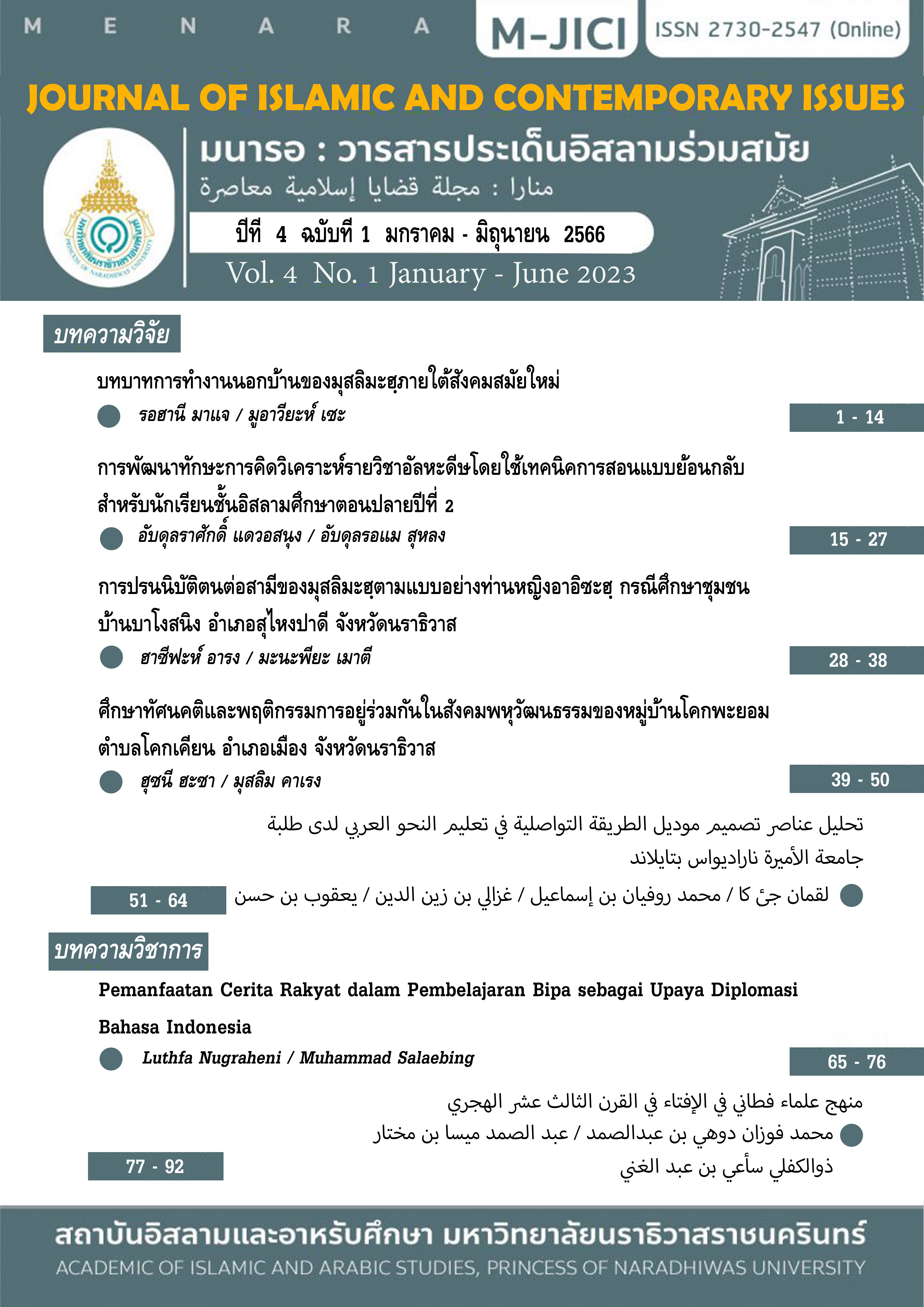The Use of Folk Stories in Learning BIPA as An Effort of Indonesian Language Diplomacy
Keywords:
Diplomacy, culture, BIPA learningAbstract
Cultural diplomacy is a form of cooperation between nations. Cultural diplomacy in this research is through learning Indonesian for Foreign Speakers (BIPA). BIPA learning not only introduces linguistic material but also introduces Indonesian culture. The purpose of this research is to utilize cultural values in folklore through BIPA learning. This type of research is descriptive qualitative with a case study approach. The data obtained in this study are cultural values in folklore from Indonesia and Thailand. The source of the data in this study is the language from the folklore of the two countries (Indonesia and Thailand). Data collection techniques used in this study were observation and documentation. Furthermore, the analytical techniques used in this research are field data collection, data reduction, data display and data verification. The selection of folklore in this study is folklore from Indonesia (Malin Kundang) and Kudus (Bulusan tradition). Furthermore, the folklore from Thailand that was introduced was the Story of a Farmer and an Angel, Island of Rats and Cats. The results that have been achieved in this study are that there are religious cultural values, honesty, hard work, independence, social care, and responsibility in the folklore of Malin Kundang. The cultural values in the Bulusan tradition are religion, discipline, and responsibility. The cultural values in the story of a farmer and an angel are honest, religious and responsible. The last folklore is the island of mice and cats, there is a cultural value of honesty and responsibility.
References
Abidin, Saebani. (2014). Pengantar Sistem Sosial Budaya di Indonesia. Bandung: Pustaka Setia.
Alqahtani, Mofareh. (2021). The Importance of Vocabulary in Language Learning and How to be Taugh. International Journal of Teaching and Education, 3 (2): 21-34.
Bascom, W. (1965). The Form of Folklore: Prose Narrative. The Hague: Mouton.
Bogdan, R. C., & Biklen, S. K. (2007). Qualitative Research for Education: AnIntroduction to Theories. Newyork: Publicher.
Budiningsih, Asri. (2013). Belajar dan Pembelajaran. Jakarta: Rieneka Cipta
Creswell, J., (2019). Research Design: Pendekatan Kualitatif, Kuantitatif, dan Mixed. Yogjakarta: PT Pustaka Pelajar.
Danandjaja, J. (2007). Folklor Indonesia: Ilmu Gosip, Dongeng, dan lain-lain. Jakarta: Pustaka Utama Grafiti.
Djelantik Sukawarsini. (2008). Diplomasi antara Teori & Praktik. Yogyakarta: Graha Ilmu
Fang, L.Y. (2011). Sejarah Kesusastraan Melayu Klasik. Jakarta: Yayasan Pustaka Obor Indonesia.
F, F. G., Saddhono, K., & Sulistyo, E. T. (2017). Fog Index on Textbooks of Indonesian Subject for Class X of Senior High School in Standard Based Curriculum (SBC) and Curriculum 2013 (A Study of Legibility and Feasibility Textbooks). Proceeding of International Conference on Art, Language, and Culture, 511–522. Retrieved from https://jurnal.uns.ac.id/icalc/article/view/16172/13010
Huberman, M &Miles, B.M. (2018). Analisis Data Kualitatif Buku Sumber Tentang Metode-metode Baru. Jakarta: UIP.
Kartika, Warsito. (2007). Diplomasi Kebudayaan: Konsep dan Relevansi Bagi Negara Berkembang Studi Kasus Indonesia. Yogyakarta: Penerbit Ombak.
Kristanto, A., Mustaji., & Andi, M. (2017). The Development of Instructional Materials E-Learning Based on Blended Learning. International Education Studies, 10(7):10-17.
Kroger, Tarja dan Anne-Maria Nupponen. (2019). Puppet as a Pedagogical Tool: A Literature Review. International Electronic Journal of Elementary Education, 11(4): 393-401.
Nugraheni, Luthfa. 2022. The Influence of Wayang Beber (The Legend of Wasis Joyokusumo) as a Character-Based Learning Media on Students' Critical Thinking Ability. International Journal of Instruction, 15(3): 267-290.
Nurlina, Laily dan Israhayu, Eko Sri. (2014). BIPA Learning Materian Development for Empowering Thailand Students Writing Competence. International Journal for Educational Studies, 7(1): 57-66.
Propp, V. (1984). Theory and History of Folklore. Third Avenue South Suite: The University of Minnesota Press.
Pujiono, Setyawan dan Widodo, Pratomo. (2021). Implementasi Budaya dalam Perkuliahan Menulis Akademik Mahasiswa BIPA Tiongkok. Jurnal: Litera, 20(1): 135-142.
Rahmawati, L. E., Suwandi, S., Saddhono, K., & Setiawan, B. 2018. Prototype of Indonesian Reading Test for the Foreign Students. International Conference on Language, Literature, and Education (ICLLE 2018), 125–134.
Ruskhan, Abdul Gaffar. (2007). Pemanfaatan Keberagaman Budaya Indonesia dalam Pengajaran Bahasa Indonesia bagi Penutur Asing (BIPA). Makalah disajikan dalam Seminar Pengajaran Bahasa Indonesia Pertemuan Asosiasi Jepang-Indonesia di Nanzan Gakuen Training Center. Nagoya: Pusat Bahasa Departemen Pendidikan Nasional Republik Indonesia.
Rokhman, F. (2012). Pengembangan model Pembelajaran Bahasa Indonesia untuk Penutur Asing dengan Pendekatan Lintas Budaya sebagai Penelitian Multikulturalisme Budaya Indonesia. Makalah Seminar Nasional PIBSI ke-XXXIV di Unsoed Purwokerto.
Sayuti, S. A. (2017). Sastra dan Budaya: Jalur Alternatif Menuju BIPA yang Bermakna. Makalah Seminar Nasional di Universitas Negeri Tidar Magelang pada 9 September 2017.
Septriani, Hilda (2021). Pemanfaatan Media Digital G Suite for Education dalam Pembelajaran BIPA Jarak Jauh di University of Vienna. Jurnal Bahasa Indonesia bagi Penutur Asing (JBIPA), 3(2): 70-77.
Suyitno, I., Gatut S., Musthofa K., & Ary F. (2017). Cognitive Learning Strategy of BIPA Students in Learning the Indonesia Language. IAFOR Journal of Language Learning, 3(2), 175-190
Tiawati R, Refa Lina. (2019). Bahasa Indonesia di Thailand menjadi Media Diplomasi Kebahasaan dan Budaya di ASEAN melalui Pengajaran BIPA. Jurnal Gramatika (Jurnal Penelitian Bahasa dan Sastra Indonesia), 1(1): 29-44.
Tulus, Warsito dan Wahyuni Kartikasari. (2007). Diplomasi Kebudayaan Dalam Konsep dan RelevansiBagi Negara Berkembang: Studi Kasus Indonesia. Yogyakarta: Ombak.
Ucus. (2015). Elementary School Teachers’ Views on Game-based Learning as a Teaching Method”. Jurnal: Procedia (Social and Behavioral Sciences),186 (2015): 401-409.
Widianto, Eko et al. (2018). Economic and Political Diplomacy in Disruption Era Through Indonesian for Speakers of Other Language (BIPA) Teacher Assignment Overseas. International Conference on Science and Education and Technology 2018 (ISET 2018) Universitas Negeri Semarang.
_______ (2021). Kesulitan Belajar Bahasa Indonesia oleh Pemelajar BIPA Level Dasar (BIPA 1) di Hanoi Vietnam. Jurnal Bahasa Indonesia bagi Penutur Asing (JBIPA), 3(2): 52-59.
Yin, R., (2009). Studi Kasus; Desain dan Metode, Jakarta: Raja Grafindo Persada.
Downloads
Published
How to Cite
Issue
Section
License
Copyright (c) 2023 MENARA : Journal of Islamic and Contemporary Issues

This work is licensed under a Creative Commons Attribution-NonCommercial-NoDerivatives 4.0 International License.



